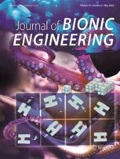Abstract
This paper presents the design and control of a pneumatically actuated transtibial prosthesis, which utilizes a pneumatic cylinder-type actuator to power the prosthetic ankle joint to support the user’s locomotion. The pneumatic actuator has multiple advantages over the traditional electric motor, such as light weight, low cost, and high power-to-weight ratio. The objective of this work is to develop a compact and lightweight transtibial prosthesis, leveraging the multiple advantages provided by this highly competitive actuator. In this paper, the design details of the prosthesis are described, including the determination of performance specifications, the layout of the actuation mechanism, and the calculation of the torque capacity. Through the authors’ design calculation, the prosthesis is able to provide sufficient range of motion and torque capacity to support the locomotion of a 75 Kg individual. The controller design is also described, including the underlying biomechanical analysis and the formulation of the finite-state impedance controller. The testing results of human subject indicate that the prosthesis is able to generate a natural walking gait and sufficient power output for its amputee user.
Similar content being viewed by others
References
Winter D A. Energy consumption and absorption at the ankle and knee during fast, natural, and slow cadences. Clinical Orthopaedics and Related Research, 1983, 175, 147–154.
Winter D A. The Biomechanics and Motor Control of Human Gait: Normal, Elderly and Pathological, 2nd ed, University of Waterloo Press, Waterloo, Canada, 1991.
Hsu M J, Nielsen D H, Lin-Chan S J, Shurr D. The effects of prosthetic foot design on physiologic measurements, self-selected walking velocity, and physical activity in people with transtibial amputation. Archives of Physical Medicine and Rehabilitation. 2006, 87, 123–129.
Torburn L, Powers C M, Guiterrez R, Perry J. Energy expenditure during ambulation in dysvascular and traumatic below-knee amputees: A comparison of five prosthetic feet. Journal of Rehabilitation Research and Development, 1995, 32, 111–119.
Au S, Weber J, Herr H. Biomechanical design of a powered ankle-foot prosthesis. Proceedings of the IEEE International Conference on Robotics and Automation, Roma, Italy, 2007, 298–303.
Au S, Weber J, Herr H. Powered ankle-foot prosthesis improves walking metabolic economy. IEEE Transactions on Robotics, 2009, 25, 51–66.
Herr H M, Grabowski A M. Bionic ankle-foot prosthesis normalizes walking gait for persons with leg amputation. Proceedings of the Royal Society B: Biological Sciences, 2012, 279, 457–464.
Hitt J, Bellman R, Holgate M, Sugar T, Hollander K. The SPARKy (spring ankle with regenerative kinetics) project: Design and analysis of a robotic transtibial prosthesis with regenerative kinetics. Proceedings of the ASME International Design Engineering Technical Conferences and Computers and Information in Engineering Conference, Las Vegas, NV, USA, 2007, 1–10.
Hitt J K, Sugar T G, Holgate M, Bellman R. An active foot-ankle prosthesis with biomechanical energy regeneration. Journal of Medical Devices, 2010, 4, 011003.
Sup F, Varol H A, Mitchell J, Withrow T J, Goldfarb M. Preliminary evaluations of a self-contained anthropomorphic transfemoral prosthesis. IEEE/ASME Transactions on Mechatronics, 2009, 14, 667–676.
Sup F, Varol H A, Goldfarb M. Upslope walking with a powered knee and ankle prosthesis: Initial results with an amputee subject. IEEE Transactions on Neural Systems and Rehabilitation Engineering, 2011, 19, 71–78.
Lawson B, Varol H A, Huff A, Erdemir E, Goldfarb M. Control of stair ascent and descent with a powered transfemoral prosthesis. IEEE Transactions on Neural Systems and Rehabilitation Engineering, 2013, 21, 466–473.
Kuribayashi K. Criteria for the evaluation of new actuators as energy converters. Advanced Robotics, 1993, 7, 289–307
Sup F, Bohara A, Goldfarb M. Design and control of a powered transfemoral prosthesis. International Journal of Robotics Research, 2008, 27, 263–273.
Versluys R, Desomer A, Lenaerts G, Van Damme M, Beyl P, Van der Perre G, Peeraer L, Lefeber D. A pneumatically powered below-knee prosthesis: Design specifications and first experiments with an amputee. Proceedings of the Second Biennial IEEE/RAS-EMBS International Conference on Biomedical Robotics and Biomechatronics, Arizona, USA, 2008, 19–22.
Versluys R, Van Ham R, Vanderniepen I, Lefeber D. Successful walking with a biologically-inspired below-knee prosthesis. Proceedings of the IEEE 11th International Conference on Rehabilitation Robotics, Kyoto, Japan, 2009, 652–657.
Seymour R. Prosthetics and Orthotics: Lower Limb and Spinal, Lippincott Williams & Wilkins, Baltimore, MD, USA, 2002.
Winter D A. Biomechanics and Motor Control of Human Movement, 2nd ed, Wiley, New York, USA, 1990.
Riener R, Rabuffetti M, Frigo C. Stair ascent and descent at different inclinations. Gait and Posture, 2002, 15, 32–44.
McIntosh A S, Beatty K T, Dwan L N, Vickers D R. Gait dynamics on an inclined walkway. Journal of Biomechanics, 2006, 39, 2491–2502.
Beater P. Pneumatic Drives: System Design, Modelling and Control, Springer-Verlag Berlin Heidelberg, New York, USA, 2007.
Goldfarb M, Barth E J, Gogola M A, Wehrmeyer J A. Design and energetic characterization of a liquid-propellant-powered actuator for self-powered robots. IEEE/ASME Transactions on Mechatronics, 2003, 8, 254–262.
Hogan N. Impedance control: an approach to manipulation: Part 1-theory, Part 2-implementation, and Part 3-applications. ASME Journal of Dynamic Systems, Measurement, and Control, 1985, 107, 1–24.
Hogan N. Adaptive control of mechanical impedance by coactivation of antagonist muscles. IEEE Transactions on Automatic Control, 1984, 29, 681–690.
Hogan N. The mechanics of multi-joint posture and movement control. Biological Cybernetics, 1985, 52, 315–331.
Author information
Authors and Affiliations
Corresponding author
Rights and permissions
About this article
Cite this article
Zheng, H., Shen, X. Design and Control of a Pneumatically Actuated Transtibial Prosthesis. J Bionic Eng 12, 217–226 (2015). https://doi.org/10.1016/S1672-6529(14)60114-1
Published:
Issue Date:
DOI: https://doi.org/10.1016/S1672-6529(14)60114-1




